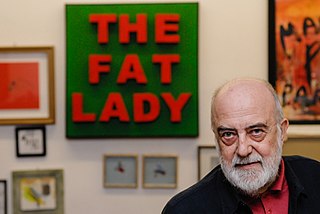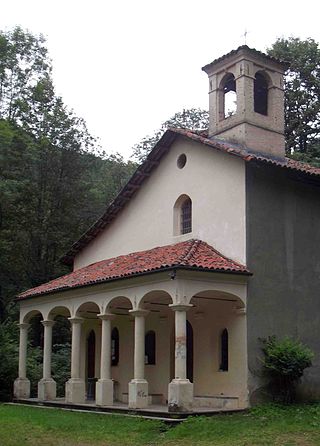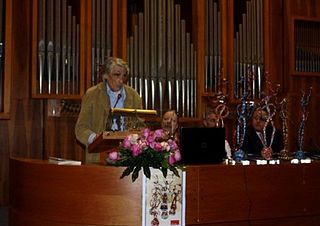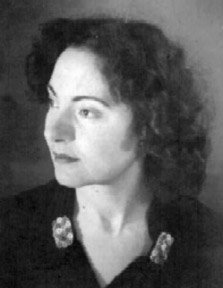Related Research Articles

Luigi Ballerini is an Italian writer, poet, and translator.
Alberto Caramella (1928–2007) spent all his life in Florence. He was an Italian poet. His first poetical works were published in 1995 after a successful career as a lawyer. In 1997 he founded the "Fondazione il Fiore" in Florence, with the aim to promote Italian and international poetry.

Refrontolo is a comune (municipality) in the Province of Treviso in the Italian region Veneto, located about 50 kilometres north of Venice and about 30 km (19 mi) north of Treviso, representing the third smallest municipality by number of inhabitants (1,732) in the province, preceded only by Portobuffolé and Monfumo. It is located in a hilly viewpoint between Quartier del Piave and Montello, and it is crossed by the Prosecco and Conegliano-Valdobbiadene Hills Wine Road established in 1966. The municipality is in fact famous for the production of the Marzemino wine. Since July 7, 2019, Refrontolo's hills have been inscribed as an UNESCO World Heritage Site as The Prosecco Hills of Conegliano and Valdobbiadene.

The Five Days of Milan was an insurrection and a major event in the Revolutionary Year of 1848 that started the First Italian War of Independence. On 18 March, a rebellion arose in the city of Milan which in five days of street fighting drove Marshal Radetzky and his Austrian soldiers from the city.

Fabio Barcellandi is an Italian poet and translator.

Giovanni Fontana is an Italian poet, performance artist, author and publisher.

Giulio Cirello was an Italian painter.

Ugo Carrega was an Italian artist and poet. Carrega was one of the main exponents of visual poetry, although he preferred the term "New Writing", an experimental form of writing that combines signs of different extraction. Carrega was active mainly in Milan, where he founded the cultural centers Centro Suolo (1969), Centro Tool (1971), Mercato del Sale (1974) and Euforia Costante (1993). He also founded and directed the art magazines Tool (1965), Bollettino Tool (1968), aaa (1969) and Bollettino da dentro (1972).

The Archivio di Nuova Scrittura is a cultural association founded in 1988 in Milan, Italy by art collector Paolo Della Grazia. The archive preserves a large artistic and documentary heritage about any form of artistic expression featuring the use of both the word and the sign. Born from the encounter between Della Grazia and artist Ugo Carrega, in the 1990s the ANS became the main Italian research center on visual poetry, organizing exhibitions, meetings and other cultural events. In 1998 the Archivio di Nuova Scrittura was deposited in part at the Mart in Rovereto and in part at the Museion in Bozen. The artwork section of the ANS includes about 1,600 works by international artists at Mart and about 2,000 at Museion. The ANS archives preserve, apart from the internal archive of the association, the Fraccaro-Carrega fonds, containing the papers of collector Marco Fraccaro and visual poet Ugo Carrega. The library section, preserved at Mart, contains more than 18,000 volumes, among them 600 artist's books and hundreds of futurist first editions, and 600 art magazines including about 300 international artist's magazines.
Marcello Landi (1916–1993) was an Italian painter and poet.

The Moglietti sanctuary is a sanctuary devoted to Our Lady of Graces in the comune of Coggiola.

Rodolfo Tommasi was an Italian journalist, writer, and musical and literary critic.
Quirino Principe is an Italian philosopher of music, Germanist, translator and dramatist. actor.
Patrizia Vicinelli was an Italian poet, writer, artist and actress.
The following is a timeline of the history of the city of Reggio Emilia in the Emilia-Romagna region of Italy.
The following is a timeline of the history of the city of Reggio Calabria, Italy.

Helle Busacca was an Italian poet, painter, and writer.

Guido Ceronetti was an Italian poet, philosopher, novelist, translator, journalist and playwright.

Claudio Damiani is an Italian poet. He was born in San Giovanni Rotondo in the south of Italy (Puglia) in 1957 though at an early age he moved to Rome, where he still lives. He made his debut in 1978 in Nuovi Argomenti, the magazine directed by Pasolini, Moravia and Bertolucci. In the first half of the 1980s he was among the founders of the magazine Braci, where a new classicism was proposed. Inspired by ancient Latin poets and by the Italian Renaissance, his themes are mainly nature and cosmos, with a side attention to current scientific research. "If the Horatian scenes of Sabina refer to a type of modern Arcadia, their specific quality is above all to approach a voice that is internal and literally poetic, refounded and reguarded like an unexpected and precious gift". His poems have been interpreted by such actors as Nanni Moretti and Piera Degli Esposti. Main prizes and awards: Premio Montale, Premio Luzi, Premio Lerici, Premio Volterra, Premio Laurentum, Premio Brancati, Premio Frascati, Premio Alpi Apuane, Premio Camaiore.
Alfredo Lucio Esposito, also known under the pseudonym of Alfredo Fiorani, was an Italian poet, writer, essayist and man of letters.
References
- ↑
- Piemontese, Felice (September 1990). Autodizionario degli scrittori italiani (01/90 ed.). Milan: Leonardo. pp. 93–94. ISBN 88-355-0077-X.
- ↑
- Caruso, Luciano (February 1997). Anabasi Senza Nome: Poesia visuale e libro d'artista in Italia. Reggio Calabria: International AM Edizioni.
- ↑ Caruso, Luciano; Polara, Giovanni (July 1969). Iuvenilia Loeti. via Lazio 9, Rome: Lerici Editore Roma.
{{cite book}}: CS1 maint: location (link) - ↑
- ↑
- Maria Martini, Stelio (March 1984). Del Poetar Citando (Luciano Caruso 1962–1983) (1 ed.). Belforte Editore Libraio. p. 101.
- ↑ Caruso, Luciano (September 2002). Personae. via Marano, 46 (UD): Campanotto Editore. pp. 8–9. ISBN 88-456-0451-9.
{{cite book}}: CS1 maint: location (link) - ↑
- Caruso, Luciano (February 1997). Anabasi Senza Nome: Poesia visuale e libro d'artista in Italia. Reggio Calabria: International AM Edizioni.
- ↑ Caruso, Luciano (September 2002). Personae. via Marano, 46 (UD): Campanotto Editore. pp. 8–9. ISBN 88-456-0451-9.
{{cite book}}: CS1 maint: location (link) - ↑ Caruso, Luciano (December 1997). Noirnul per burri - per villa: libro-opera 1969 (Esemplare N. 31 ed.). via Grande 91, Linvorno: Belforte Editore Libraio.
{{cite book}}: CS1 maint: location (link) - ↑ Tecce, Angela; Villa, Emilio; Bandini, Mirella; Zanchetti, Giorgio (May 1995). Alchimia della Scrittura – Luciano Caruso, Opere 1963 – 1995. Livorno: Belforte Editore Libraio. p. 108.
- ↑ Tecce, Angela; Villa, Emilio; Bandini, Mirella; Zanchetti, Giorgio (May 1995). Alchimia della Scrittura – Luciano Caruso, Opere 1963 – 1995. Livorno: Belforte Editore Libraio. pp. 27–28.
- ↑ Caruso, Luciano; Piancastelli, Corrado (December 1968). Il gesto poetico: antologia nella nuova poesia d'avanguardia. Via Poggio de' Mari, 16 Naples: Enzo Portolano Editore.
{{cite book}}: CS1 maint: location (link) - ↑ Manifesti e Documenti teorici del Futurismo 1909–1944. Spes-Salimbeni, Florence.
- ↑ Higgins, Dick. "Lettere di Dick Higgins a Luciano Caruso" (1976-1994) [Letters]. Archivio Luciano Caruso, Box: 23, File: 15, ID: 2, pp. 44. Via de Ginori, 23: Archivio Luciano Caruso. 1976–1994.
- ↑
- Caruso, Luciano (February 1997). Anabasi Senza Nome: Poesia visuale e libro d'artista in Italia. Reggio Calabria: International AM Edizioni.
- ↑ Piscopo, U.; Paloscia, T. (1999). La via della seta 1991–1999. Villa Erba, Cernobbio: IdeaComo.
- ↑ Parmiggiani, Claudio (2002). Alfabeto in sogno. Foro Buonaparte 52, Milano: Mazzotta. pp. 299–342. ISBN 88-202-1532-2.
{{cite book}}: CS1 maint: location (link) - ↑
- Moio, Giorgio; Della Ragione, Pasquale (March 2014). Risvolti: rassegna aperiodica di linguaggi in movimiento. N. 20 – Anno XVII – Nuova Serie. Giugliano in Campania-Licola (NA): Edizioni Riccardi. p. 28.